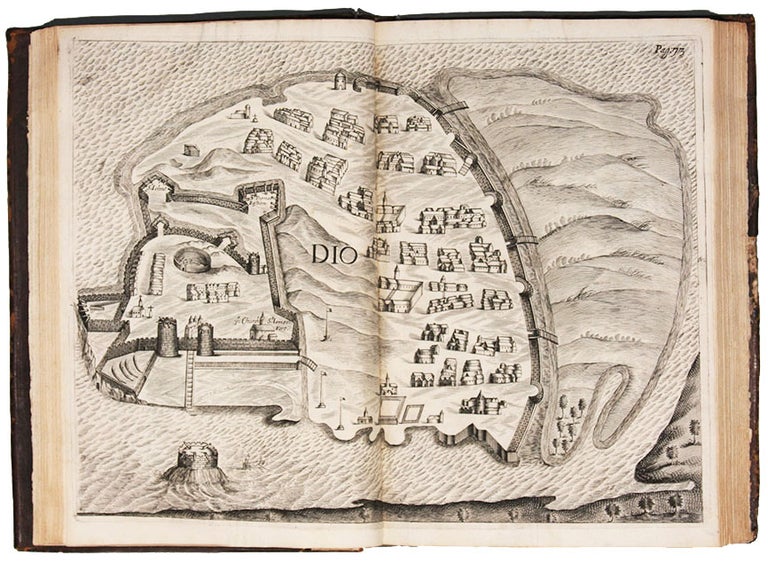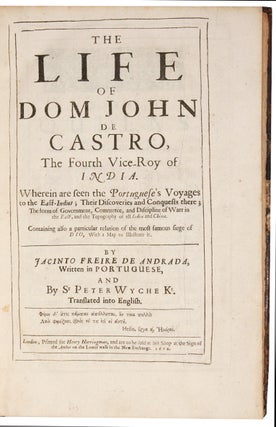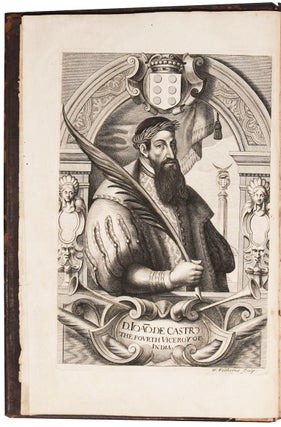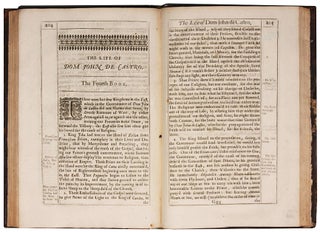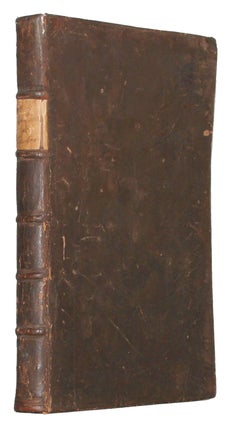The Life of Dom John de Castro, the Fourth Vice-Roy of India ... Containing also a particular relation of the most famous siege of Dio.
Folio [28.5 x 18.5 cm], engraved frontis portrait, (10) ff., 272 pp., (10) ff., with engr. plate following p. 35 and double-page engr. map following p. 72. Contemporary English calf, ruled, spine with six compartments and paper title label. Gnawed at lower edge of final 16 ff. Some rubbing to joints and extremities, front & back pastedowns loose. Minor wear to joints. First edition in English, first issue of the most famous biography in the Portuguese language. D. João de Castro (b. 1500, Lisbon) was a sailor, soldier, scientist and cartographer. At an early age he became a brilliant humanist, studying mathematics under Pedro Núñez. After fighting at Tangiers and Tunis, he sailed for the Indies, where he enlisted among the aventureiros (“the bravest of the brave”) sent to relieve Diu. Back in Portugal in 1543, he was named commander of a fleet sent to clear the European seas of pirates, and two years later was sent with a fleet of six ships back to the Indies. By his overthrow of Mahmud, King of Gujarat, by the relief of Diu, and by the defeat of the great army of Adil Khan, de Castro achieved such popularity that the merchants of Goa were willing to make him a substantial loan with only his moustache as security. De Castro soon captured Bharuch (Broach) on the west coast of India and completely subjugated Malacca. In 1547, he was appointed Viceroy of India, but died the next year in the arms of his friend St. Francis Xavier De Castro is famous not only for his successful military campaigns, but also for his measurements and analysis of geomagnetic data, which he collected during his travels. His measurements of magnetic declination in the Atlantic and the Indian Oceans led to his recognition as one of the most important maritime scientists of the time. In fact, “none of the early observers (scholars and navigators) matched D Joao de Castro in measuring the large-scale pattern of geomagnetic declination field” (Trigo, Vaquero, p. 2.14). The data collected by de Castro is of great significance for the study of long-term changes in the magnetic field of our planet. The Vida de D. João de Castro (Lisbon, 1651) by Jacinto Freire de Andrada (1597-1657) has been at times regarded as a model of Portuguese prose and other times has been roundly criticized for its style. One of the author’s most remarkable literary devices was the use of imaginary letters from D. João concerning problems such as the Turkish threat and attacks on missionaries. This edition includes a frontispiece portrait engraved by the English painter and engraver William Faithorne (1616-1691), an engraving of a miraculous crucifix whose ancient lettering was said to record the death of St. Thomas in Meliapor (see pp. 36-37), and a double-page plan of the siege of Diu. The English translation is by Sir Peter Wyche (1628-1699?), a charter member of the Royal Society who also served as chairman of a committee charged with improving the English language and as envoy extraordinary to Russia. The sheets of this edition were reissued in 1693 with a new title page. *Wing F2155; Alden & Landis 664/81; Innocencio III, 240; Barbosa Machado II, 465; Allison F.15 (without collation); Floor and Hakimzadeh, The Hispano-Portuguese Empire and Its Contacts with Safavid Persia, pp. 168-169; Trigo, Vaquero, “An unsung hero” in Astronomy and Geophysics, 49 (2008): pp. 2.14–2.16.
* Wing F2155; Alden & Landis 664/81; Innocencio III, 240; Barbosa Machado II, 465; Allison F.15 (without collation).
Price: $0.00

